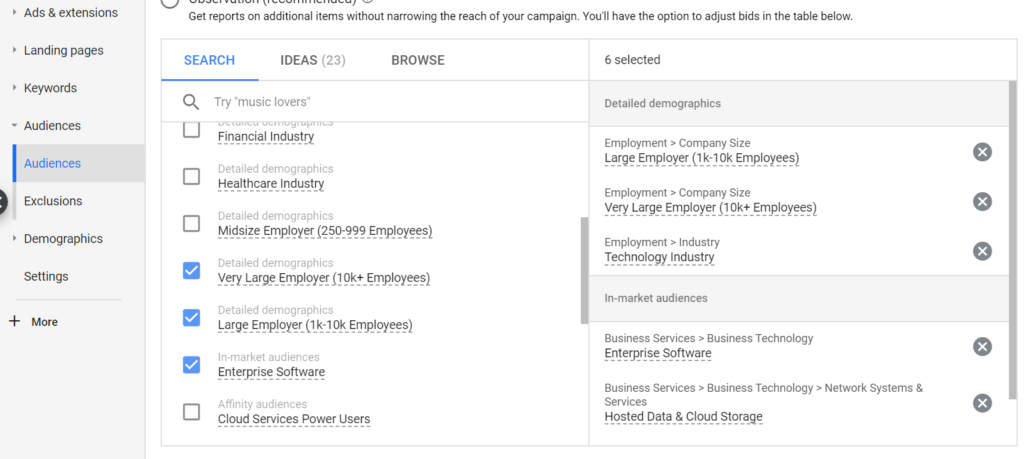A significant portion of Google Ads for SaaS companies paid acquisition strategy should be focused on capturing buyers that are actively looking for a solution - with intent to buy.
The best way to find these buyers is through paid search acquisition.
In many tests, we’ve found Google Ads to be the best at driving a significant amount of inbound leads, but Bing will drive them at a substantially lower cost. You should be leveraging both channels.
During our marketing performance assessment it’s not uncommon for us to recover 30% - 70% of wasted ad spend. You can book a discovery call to get the process started.
For some SaaS companies it takes years to realize how much spend they’ve wasted. This process doesn’t start until the executive team starts asking difficult questions on how much is spent and what revenue it drives.
I’ve had one CEO flat out ask “We’re spending $1MM a year on paid search and I’m not sure if it even works.”
Success on Paid Search for SaaS Companies
Paid search is best utilized as an intent driven channel that drives demo requests, free trials, and chats and should under no circumstances be leveraged as a top of the funnel strategy.
We believe in a top of the funnel strategy we just have found better channels to drive top of the funnel awareness outside of paid search.
In every account we’ve audited, top of the funnel keywords turn to revenue at less than 1%.
So here is the exact formula we leverage to cut wasted spend and drive revenue. It’s an accumulation of 48 months of learning, and over $25MM in ad spend.
Stage 1: Campaign Development & Validation
Your entire paid search strategy needs to be driving the bottom of the funnel buyers that are actively looking for your solution.
Start by building campaigns with broad match modified keywords that would indicate intent.
Intent keywords are the key to keeping budget aligned and the foundation of the entire strategy. This includes keyword targets such as: platform, software, vendor, trial, demo, pricing, solution, tool, etc.
With intent driven keywords as part of your mix you’ve narrowed in on buyers actively looking to buy.
Your initial campaign will look something like this:
In this example we built our bottom of the funnel with broad match intent based keywords.
These are buyers actively looking for an ABM solution.
You can take this approach as broad as you want such as targeting +account +marketing +software as long as it has the intent based keyword.
Once your campaigns are created you need to load it up with observational audiences. This will help us uncover what audiences are in-market and allow us to scale and grow the account in the future.

Think outside the box and consider adding income, gender, industry, and company size (beta audiences - get these).
Stage 2: Scaling & Growth
When scaling paid search accounts the theory is to start adding broader and broader keywords. This works, but overtime becomes more and more inefficient and expensive. Your CAC goes through the roof even when you might have a great cost per lead metric.
Here’s how to scale the account in a way that aligns with revenue.
First start mining your search terms from your broad match campaigns and extracting them into a new campaign for exact matches.
As you add exact match campaigns make sure you negate the search term out of the broad match modified campaign (you want traffic to go to your exact match campaign).
Over time this will greatly reduce your spend. Eventually you’ll be left with campaigns that convert at a high percentage and you’ve freed up a ton of spend.
Start reviewing your observational audiences and identifying converters.
With this data you can start broad match campaigns without the intent keyword. Combine these new campaigns with targeted audiences and test combined targeted audiences based on what has driven conversions in the past.
This is going to cut out 50% - 90% of searches and keep your budget in check.
BOOM. You’re now targeting broad match keywords based on audiences showing intent. You’ll save a shitton of cash with this approach.
As before, as you identify exact match keywords move them into a seperate exact match campaign.
At this point you can continue to test broad match keywords with your audience campaigns.
Over time you will tweak and dial in your audiences and continue to test different broad match terms as you continually identify new winners.
There is a point where this strategy plateaus. It’s critical you recognize this plateau instead of continually increasing budget trying to find more leads. When you reach the plateau it’s critical that you start focusing on channel efficiency and optimization not growth.
Account Structure & Strategy is the Difference
This is just one of many of one strategies in our paid search mix, but it serves as a strong foundation to build out your account in a way that’s scalable and more importantly profitable.
In one recent example, we restructured an account for a SaaS company spending $30k/mo in paid search. Leveraging this approach we increased inbound lead volume by over 80% month over month.
No whitepaper promotions or ebook downloads that don’t turn to revenue. Sending people to your get a demo / free trial offer.
Your account structure and keyword strategy is the difference between winning and losing and will dictate the long term performance of your paid acquisition strategy.
Don’t be fooled by lowering CPA, CPC, and CPL metrics - they often don’t align to actual revenue results.
Schedule a discovery session and let’s discuss your paid acquisition strategy.